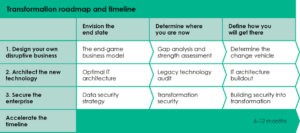Anyone who’s spent time in London will have fond memories of lazy Sundays spent in the pub, slowly working your way through your favourite paper. Call me odd, but my favourite London memory came regular as clockwork two days earlier – Friday was the day The Economist popped through my front door, guaranteeing a week’s worth of high quality and thought provoking reading.
Those warm memories came flooding back earlier this week when I came across this piece of sponsored content from Hewlett Packard and The Economist’s Intelligence unit. It aligns perfectly with much of this blog’s thinking over the last twelve months. Please take time to read the piece in its entirety – it will be a well-rewarded investment. Here’s my summary:
- Create the end-game business model… this is similar to what I have been saying here, here and here
- Do your gap analysis and strength assessment… ditto to my above comment
- Execute – this is your vehicle for digital change
- Define your optimal IT architecture
- Run a legacy technology audit
- Build out the IT architecture
- Create and set a data security strategy
- Maintain security during your transformation
- Transformation is an opportunity… Remember, value is always temporary…. recognising that can be scary or it can fill you with excitement at the endless possibility. It’s your choice,
Outside the nine steps the piece also has several key insights, again very much in line with our blog discussions.
- Accelerate the timeline for disruption. or as I have been saying someone, somewhere is already figuring out how to disrupt you.
“The agility of the new disruptors and the potential agility of your competitors mean that digital transformation cannot be business as usual…. Most business transformations should take place between six and 12 months”
- Co-opt the insurgents. Absorbing your most potent digital competitors can bring a ready-made business model, culture, and employees into your enterprise. This leads to some important secondary considerations that are worth you thinking about:
- How do I best set up a ventures/incubator model?
- What privileged assets do I have? How can I leverage these to acquire or to drive JV with other insurgent start-ups in the name of driving growth? Media is a good place to see this in action… “advertising for equity” or “air for share”
- Select and engage strong partners. Does your current team really have the capability and capacity to create a new business? How do you leverage outside help to bring fresh thinking and speed up this process?
Key Takeaway
As the Chinese proverb goes “The best time to plant a tree was 20 years ago. The second best time is now”. The best time to disrupt your business was yesterday. The second best time is today.





